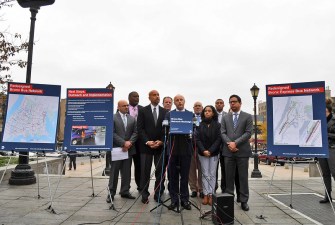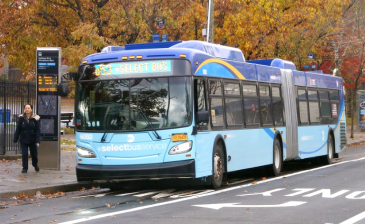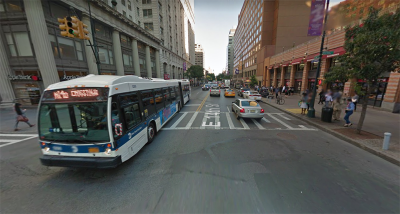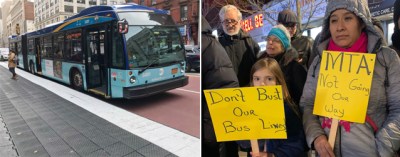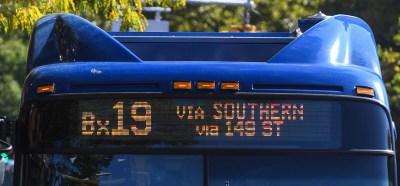Want to Fix Brooklyn’s Bus System? Remove Half the Stops
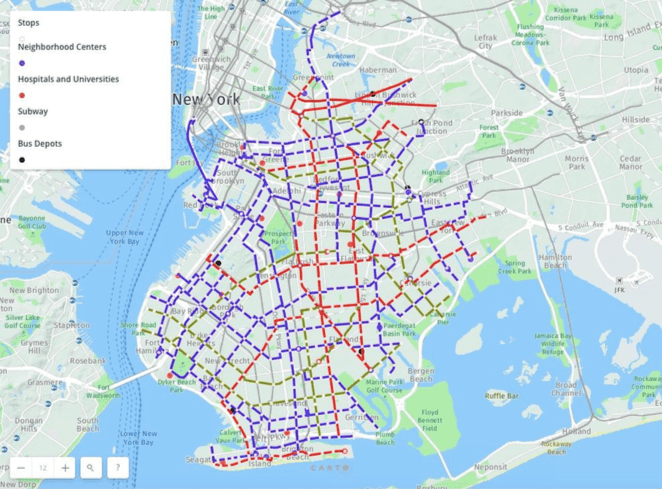
A radical plan to improve bus service in Brooklyn is a bit like the transportation version of the last scene of “Avengers: Infinity War” — half of the bus stops in the borough will have to disappear as if vaporized by Thanos.
A plan by academics Eric Goldwyn and Alon Levy would cut the existing 1,566 stops on 54 lines to roughly 700 on 37 lines, reducing the overall size of the bus network from 335 miles to 215. The result, they say, will be an increase in bus speed in the most-populous borough from the current average of 6.8 miles per hour to 9.3.
That’s a 40% gain. But removing half the stops would cause a lot of pain, too.
“It’s a win-lose proposal,” said Goldwyn, a research scholar at the NYU Marron Institute of Urban Management and an urban planner who presented his plan Wednesday to TransitCenter. “We don’t think everyone will be happy … at the beginning.”

Goldwyn said he and Levy know that consolidating some routes, combining parallel routes and eliminating stops is the third-rail of bus service — but said he answered to a higher goal: improving service in a borough where ridership has dropped close to 20% since 2008.
“Everyone recognizes there is a crisis in our bus network,” Goldwyn said. “If we don’t want to make anyone angry, we won’t make change, but things will continue to suck. If we are not willing to make a dramatic intervention, we won’t have a good bus network.”
Among the proposals:
- Reducing duplicate service and overlays with existing subway lines, which planners say would improve speeds by 20%.
- Redesigning some streets to prioritize buses over parking, such as on Nostrand Avenue, which could be converted to a two-way bus route if one lane of parking was removed. More dedicated bus lanes could improve speeds by 11%.
- Installing pre-pay machines at more bus stops to speed entry.
- Eliminate some bus-to-bus transfer points. Goldwyn and Levy found that in New York, only 3% of riders transfer from a bus to another bus (most people with two-seat rides go from a bus to the subway).
- Eliminating many stops. The current average distance between stops — roughly 740 feet — would grow to 1,620 feet.
“Yes, some of the time gained from faster buses would be lost by extra walking time, but the gain is larger than the loss,” Levy said.
Politicians tend to protest any change along any bus line (looking at you, B82), but Goldwyn said agency engineers and planners see the benefits.
“This is a technical solution,” he said. “We all recognize there’s a crisis on the bus network. It is shitty. And the only way to make it better is to make win-lose tradeoffs. We can’t sugar coat.”
After our first edition of this story was published, an MTA source did not throw the coldest bucket of water on the visionary plan, pointing out that the agency’s Fast Forward Plan already calls for redrawing the bus map in every borough (the Bronx is first).
And DOT issued this statement through spokesperson Lolita Avila:
DOT and MTA are continuously working on new solutions to improve bus services for New Yorkers and we appreciate that civic institutions are also interested in enhancing the commute for thousands of bus riders. We are in full support of the MTA’s Fast Forward efforts and we are beginning to look at street design as part of the first bus network redesign in the Bronx. Successful bus route redesign will consider access to stops, transfer time, and the allocation of street space in communities, while concentrating more service on select high volume routes, adjusting stop spacing, giving buses more priority, and improving fare collection procedures.
Story was updated at 11 p.m. on Wednesday to add in MTA context and at 11 a.m. on Thursday to add in the DOT.


